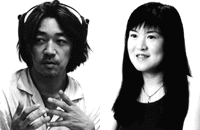
Feagufd: music/noise--21st-Century Alternatives
Opera / Internet / Noise
No material in this page may be reproduced,
in whole or in part, in any form without permission.
DIGITAL MEDIA
Musical Digit-ization and Transformation
TANABE Mitsuru (TM): One has the impression that you have a fundamental attraction to new forms of media. You were an early user of CD and DAT formats, and lately your work on the Internet has gained quite a reputation, too . . . .
SAKAMOTO Ryuichi (SR):Yes, I would agree that I am interested in new media forms, and that I'm typically an "early user." When CDs first came out, I exchanged all of my analog records for CDs. The analog tape recorder that I was using in the studio got traded in for a digital one as soon as they were available. Back when I was still in YMO [Yellow Magic Orchestra, a seminal electronic pop music band which Mr. SAKAMOTO was a founding member of], I had already switched, for the most part, to digital. Ever since—except for occasions when I have wanted a particular analog sound for some special reason—I have been using a fully digital work environment. Why have I . . . ? I don't know, I guess I just like it better. Let me try to explain.
Maybe that it's just that I like the sense of quantification in "numericizing" the parameters that I'm working in. Once things have been made digital—expressed in digits—it doesn't matter how the hardware or media changes, the data gains a semipermanent state. Analog formats are where information has been placed on a carrier, imprinted on a substance, or otherwise given a temporary stability in an object, so that as the object loses fidelity the information loses fidelity with it. I am not immune to the appeal of analog formats' crafted glass-like transience, but at the same time, I'm also fascinated by the evolution towards numerical quantification in music that has been so important since I was in my teens. Since around the beginning of this century, in fact, there has been a steady movement towards finding ways to explore the potential of "digit"-ized music. Twelve-tone scales, serial technique . . . XENAKIS and others have been in the avant-garde of this experiment. I consider it a natural path of exploration.
Music is, at its most essential, sound waves. Information riding on air. It dissipates into the environment if not acted upon. And yet, about 100 years ago, the means for objectifying it, for placing it on media and turning it plastic were invented. This was followed, in the last decade by the development of ways to "digit"-izing it, so that it is no longer plastic, yet neither does it vanish. The ability to maintain it as pure information is revolutionary, in my opinion. If you consider human civilization as something that goes back 5,000 years, the changes in music in these 100 or even 10 years really are fantastic. Plus, through this digitization, the new ease of converting or manipulating it are really fascinating. By playing with the digits, you can create sounds that hadn't existed before.
TM: Last year your collaboration with IWAI Toshio, <<Music Plays Images X Images Play Music>> provided just such an opportunity—to use sounds to trigger visual data. How do you read this work? For example, as composing music while watching its visual counterpart, or playing visual compositions, or . . . ?
SR:I often compose music to moving images. I have made several film soundtracks, or, even if the visuals are not that specific, I often have visuals in mind, whether as a landscape I recall, or by looking at pictures, or imagining purely abstract plays of light. My sessions with IWAI were such that the visuals responded instantaneously with my performance, colors and shapes and motions appearing on the display as soon as I'd played them. It was not unlike using a trackball on a computer to draw lines or circles in making a composition on the screen. It was an experience of using a piano to paint pictures.
I'd want a certain icon to appear in a certain area, or want a fluttering motion in a given area, or I'd want a similar effect to happen in a different area of the screen, etc., so I'd play the appropriate area on the piano keyboard to get the effect I wanted. I was watching the screen the whole time. It was a system that IWAI designed, and I was more or less playing with his application, as it were. It wasn't really music and it wasn't really moving image, but rather exploring the place where the two meet. A kind of media art.

 Next
Next